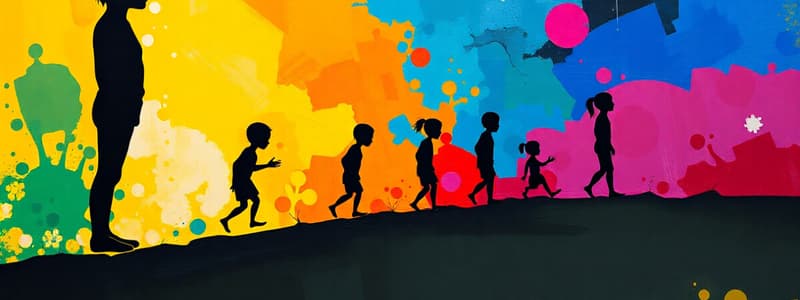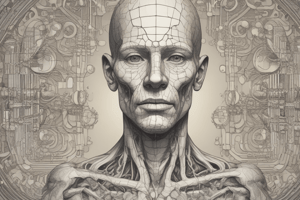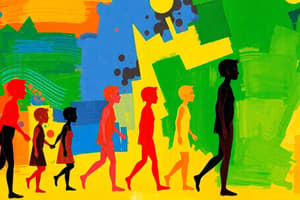Podcast
Questions and Answers
What is defined as the physical increase in size and appearance of the body?
What is defined as the physical increase in size and appearance of the body?
- Functionality
- Development
- Maturation
- Growth (correct)
Which of the following is a qualitative change in a child's functioning?
Which of the following is a qualitative change in a child's functioning?
- Development of language skills (correct)
- Accumulation of body fat
- Increase in height
- Increase in muscle mass
Which factor is NOT mentioned as influencing growth and development?
Which factor is NOT mentioned as influencing growth and development?
- Genetic influences
- Environmental influences
- Endocrine influences
- Economic factors (correct)
How can growth be measured in a child?
How can growth be measured in a child?
What characterizes development in children according to the content?
What characterizes development in children according to the content?
Which measurement is NOT typically associated with growth?
Which measurement is NOT typically associated with growth?
What does the process of maturation result in?
What does the process of maturation result in?
Which term relates to the ongoing processes of physiological changes throughout life?
Which term relates to the ongoing processes of physiological changes throughout life?
In what way is growth described in the content?
In what way is growth described in the content?
What is the correct order of the stages in the prenatal period?
What is the correct order of the stages in the prenatal period?
At what age range is a child considered to be in the toddler stage?
At what age range is a child considered to be in the toddler stage?
Which type of growth involves increases in sensory acuity and gross motor skills?
Which type of growth involves increases in sensory acuity and gross motor skills?
Which age range typically corresponds to early childhood?
Which age range typically corresponds to early childhood?
What developmental aspect is characterized by children constructing detailed stories by age 5?
What developmental aspect is characterized by children constructing detailed stories by age 5?
Gross motor skills primarily involve which type of movements?
Gross motor skills primarily involve which type of movements?
What is a key milestone in physical development during the first two years of life?
What is a key milestone in physical development during the first two years of life?
Which of the following is NOT a characteristic of gross motor development?
Which of the following is NOT a characteristic of gross motor development?
What aspect of growth includes the development of muscular control?
What aspect of growth includes the development of muscular control?
At what stage do children typically begin developing coordination?
At what stage do children typically begin developing coordination?
What is the primary focus of fine motor skills development in children?
What is the primary focus of fine motor skills development in children?
What is a significant change in vital signs as children grow older?
What is a significant change in vital signs as children grow older?
When do infants typically double their birth weight?
When do infants typically double their birth weight?
What weight change do most babies experience in the first week after birth?
What weight change do most babies experience in the first week after birth?
What is a good criterion for assessing a child's growth and health status?
What is a good criterion for assessing a child's growth and health status?
What parameter is NOT typically used to assess physical growth in children?
What parameter is NOT typically used to assess physical growth in children?
What is a key indicator of developmental milestones in infants?
What is a key indicator of developmental milestones in infants?
Which of the following types of development primarily focuses on emotional changes?
Which of the following types of development primarily focuses on emotional changes?
What is a common characteristic of growth spurts in children?
What is a common characteristic of growth spurts in children?
What factor is NOT considered a postnatal factor affecting growth and development?
What factor is NOT considered a postnatal factor affecting growth and development?
Which statement best describes the rate of growth in children?
Which statement best describes the rate of growth in children?
Which aspect primarily defines physical growth?
Which aspect primarily defines physical growth?
How can mastery of developmental tasks change over time?
How can mastery of developmental tasks change over time?
Which of the following is a genetic factor affecting growth and development?
Which of the following is a genetic factor affecting growth and development?
Which type of development is characterized by cognitive, social, and emotional changes?
Which type of development is characterized by cognitive, social, and emotional changes?
What does the cephalocaudal pattern of development signify?
What does the cephalocaudal pattern of development signify?
In which pattern does the trunk develop before the extremities?
In which pattern does the trunk develop before the extremities?
How do prenatal factors primarily affect growth and development?
How do prenatal factors primarily affect growth and development?
What does the term 'general to specific' refer to in the context of child development?
What does the term 'general to specific' refer to in the context of child development?
Which of the following is a common misconception about growth?
Which of the following is a common misconception about growth?
What distinguishes development from growth?
What distinguishes development from growth?
What role do heredity and environment play in development?
What role do heredity and environment play in development?
Which factor is NOT considered when assessing postnatal growth and development?
Which factor is NOT considered when assessing postnatal growth and development?
How does the speed of developmental progress differ among children?
How does the speed of developmental progress differ among children?
Which of the following statements is inaccurate regarding developmental stages?
Which of the following statements is inaccurate regarding developmental stages?
What is the correct definition of the proximodistal pattern in development?
What is the correct definition of the proximodistal pattern in development?
Study Notes
Introduction to Human Growth and Development
- Growth and development are ongoing processes encompassing physiological and psycho-emotional changes throughout the lifespan.
- These processes are interlinked and influenced by genetics, hormones, environment, nutrition, and constitution.
Growth
- It's the increase in physical size and appearance due to new cell formation.
- Measured using anthropometry (weight, height, head, and chest circumference), tissue growth assessment (muscle mass, skin fold thickness), bone age (radiological assessment of epiphysis), dental age (counting erupted teeth), and histological methods.
Development
- It's the progressive increase in skills and functional ability, becoming more complex through growth, maturation, and learning.
- A qualitative change in functioning, often assessed through observation.
- Includes the acquisition of gross and fine motor skills, personality, and mental development.
Developmental Milestones
- Age-dependent cues observed through interactions with surroundings, movement, and gestures.
- Examples: smiling, waving, babbling, and playing with toys.
Types of Growth and Development
Growth
- Physical Growth: increase in bone, muscle, and fat.
- Physiological Growth: changes in vital signs (e.g., pulse, respiration, blood pressure)
Development
- Motor Development: gross (large muscle) and fine (small muscle) motor skills.
- Cognitive Development: intellectual growth, problem-solving, and language.
- Emotional Development: understanding and expressing emotions.
- Social Development: interacting with others and building relationships.
- Moral and Spiritual Development: developing values, beliefs, and ethics.
Factors Affecting Growth and Development
- Genetic factors play a crucial role, including sex and race.
- Prenatal factors (intrauterine environment) are influential:
- Maternal malnutrition
- Maternal infection
- Maternal substance abuse
- Maternal illness
- Hormones
- Postnatal Factors:
- Nutrition
- Socioeconomic status
- Childhood illnesses
- Number of siblings
- Physical environment
- Play and exercise
- Psychological environment
- Intelligence
- Cultural influence
- Family structure
- Hormonal influence
Growth and Development: Key Differences
- Growth is a quantitative change (size, weight, etc.).
- Development is a qualitative change (cognitive, social, emotional).
- Growth is limited in duration, stopping at maturation.
- Development continues throughout life.
Principles of Growth and Development
- Growth and development occur in spurts, preparing for developmental milestones (walking, talking, etc.).
- Not all body parts develop at the same rate.
- Individual differences exist in growth and development.
- Mastery of developmental tasks is not static or permanent (illness or stress can cause regression).
- Developmental stages may not correlate with chronological age.
- Development is influenced by both heredity (genetics) and environment.
Directional Patterns of Growth and Development
- Cephalocaudal (Head to Foot): Head develops first, followed by the trunk and legs.
- Proximodistal (Near to Far): Development progresses from the trunk outwards (e.g., body to arms to hands to fingers).
- General to Specific: Activities become less generalized and more focused as a child matures.
- Simple to Complex: Skills become increasingly complex, using building blocks for future learning.
Developmental Age Periods
- Prenatal (Conception to Birth):
- Germinal (Conception to 2 weeks)
- Embryonic (2 to 8 weeks)
- Fetal (8 to 40 weeks)
- Infancy (Birth to 1 Year):
- Neonatal (Birth to 28 days)
- Infancy (1 to approx. 1 year)
- Early Childhood (1 to 6 Years):
- Toddler (1 to 3 years)
- Preschool (3 to 6 years)
- Middle Childhood (6 to 11 or 12 Years): School age
- Late Childhood (11 to 18 Years):
- Prepubertal (10 to 12 years)
- Adolescence (13 to approx. 18 years)
Types of Growth and Development (Categorized)
- Physical/Physiological (growth in bone, muscle, fat, and physiological changes)
- Cognitive/Intellectual (development of thinking, reasoning, and memory)
- Emotional and Social (Psychosocial) (developing emotional intelligence and social skills)
- Speech and Language (communication development)
Physical Development: Gross and Fine Motor Skills
- Gross motor skills involve large muscle movements (walking, jumping, throwing).
- Fine motor skills use smaller muscles for precise actions (drawing, writing, buttoning clothes).
- Physical development is critical for interacting with the world and exploring.
Monitoring Growth and Development
- Parameters for assessing growth:
- Height
- Weight
- Head circumference
- Chest circumference
- Teething/Dentition
Weight Gain
- Weight gain is a crucial indicator of growth and overall health.
- Babies born full-term typically weigh between 2.5 kg to 3.5 kg.
- Most babies lose a little weight after birth (around 10%) but regain it within 10 days.
- Weight gain is approximately 25-30 grams per day for the first 3 months and 400 grams per month until one year of age.
- Infants double their birth weight by 4-6 months and triple it by one year.
Length and Height
- Increase in height signifies skeletal growth.
Studying That Suits You
Use AI to generate personalized quizzes and flashcards to suit your learning preferences.
Related Documents
Description
This quiz explores the fundamental concepts of human growth and development, covering physiological and psycho-emotional changes across the lifespan. It investigates various assessment methods used for measuring growth and the qualitative changes that occur during development. Test your understanding of these critical processes!




